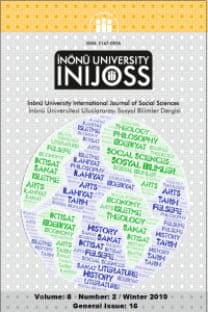GOTHIC AND TRAUMA: THE AMBIGUITY OF SUFFERING IN CHRISTINA ROSETTI’S “GOBLIN MARKET”
Christina Rossetti’nin "Cin Pazarı" şiirini ele alan çalışmalar, şiirdeki anlam belirsizlikleri ve şiirin sunduğu sayısız yorumla da ilgilenmelidir. Rossetti, "Cin Pazarı"nın bir çocuk hikayesi olduğunu iddia etmiştir ve metnin üstünkörü bir şekilde okunması bu iddiayı doğrulamaktadır. Şiir, küçük bir vadide anlatıcının deyimiyle bir grup "goblin adam" ile karşılaşan kız kardeşler Laura ve Lizzie hakkındadır. Laura goblinlerin bir tutam saç karşılığı meyve ikram etme davetine çabucak kanarken, Lizzie goblinlere direnir ve kaçar. Laura meyveleri bitirip eve gittikten sonra daha fazla meyve isteğiyle hastalanır. Sonunda Lizzie, goblinlerle yüzleşir ve kız kardeşini iyileştirir. Rossetti’nin bunun çocuklara yönelik bir hikaye olduğu iddiasına rağmen, eleştirmenler şiiri bir Hıristiyanlık alegorisi; uyuşturucu bağımlılığına karşı uyarıcı bir hikaye; proto feminist ve kadın dayanışmasını öven bir şiir; erotik bir anlatı; kapitalizm eleştirisi; ve Gotik bir peri masalı gibi bambaşka şekillerde yorumlamışlardır. Gotik türü, yaygın bilinen tanımının yanı sıra bir travma anlatısı olarak da tanımlanabilir, çünkü Gotik eserlerde çoğu zaman ana karakterler kendilerini strese sokan ve hayatlarını kökten değiştiren şok edici olaylar yaşarlar. Benzer şekilde klinik anlamda travma da hastalarda sürekli bir tehlike beklentisi, zaman ve mekân karmaşası ve zihni rahatsız eden şeylere karşı psikolojik teslimiyet şeklinde kendini gösterir. Tüm bu klinik belirtiler “Cin Pazarı” şiirinin satır aralarında kız kardeşlerin olaylara verdikleri tepkilerde de gözlemlenebilir. Goblinlerin muğlak doğası; şiirin gündüz ve gece döngüsü üzerine vurgusu ve Laura’nın çektiği çilenin belirsiz nedeni, "Cin Pazarı"ndaki Gotik unsurlardan yalnızca birkaçıdır. Bu bağlamda, bu makale Christina Rossetti’nin “Cin Pazarı” şiirinde çile ve travmanın temsili ile yakından bağlantılı olan çeşitli Gotik özellikleri ele almaktadır.
"Twilight is not good for maidens": The Gothic and the Ambiguity of Suffering in Christina Rosetti's "Goblin Market"
Any critical study dealing with Christina Rossetti’s “Goblin Market” must also deal with the poem’s ambiguity and the numerous interpretations it offers. Rossetti claims “Goblin Market” is a story for children and a cursory reading of the text affirms this suggestion. The poem is about Laura and Lizzie, two sisters who come across a group of “goblin men” in a glen who call the sisters to “come buy” the uncannily attractive selection of fruit they sell. While Laura is quickly enticed by their invitation, Lizzie resists the temptation and runs away. After eating them, Laura becomes fixated in the fruit, but can no longer find the goblin men and falls sick. In the end, Lizzie confronts the goblins and cures her sister. Despite Rossetti’s claim, critics have read the poem as diversely as a Christian allegory; a cautionary tale against drug addiction; a proto-feminist celebration of female solidarity; an erotic narrative; a criticism of capitalism; and as a Gothic fairy-tale. Among its various definitions, Gothic can also be identified as a narrative of trauma since central characters in Gothic typically experience some shocking incident that intensely distresses them and roots out their lives. Similarly, trauma manifests itself in the constant anticipation of danger, confusion of time and place, and psychological surrender to what is threatening the psyche, which are identifiable themes in “Goblin Market” as well. The ambiguous nature of the goblins; the emphasis on day and night cycles, and the obscure nature of Laura’s suffering are only a few of the Gothic elements in “Goblin Market”. In this respect, this paper deals with various Gothic features in Christina Rossetti’s “Goblin Market” which are intricately connected to the representation of suffering and trauma in the poem.
___
Albright, K. J., & Duggan, C. H. (2008). Analyzing Trauma Narratives: Introducing the Narrative Form Index. Rehabilitation Psychology, 53(3), pp. 400-411. Retrieved from http://dx.doi.org/10.1037/a0013040
Caruth, C. (1996). Unclaimed Experience: Trauma, Narrative and History. Baltimore: The John Hokins UP.
Crawford, J. (2010). Recurring Nightmares and the Repetition Compulsion in Gothic Fiction. MoveableType, 6. Retrieved from https://www.ucl.ac.uk/moveable-type/sites/moveable-type/files/Crawford.pdf
Erikson, K. T. (1976). Collective Trauma: Loss of Communality. In K. Erikson, Everything in its Path: Destruction of Community in the Buffalo Creek Flood. New York: Simon&Schuster.
Freud, S. (1960). Beyond the Pleasure Principle. New York: W. W. Norton & Comp.
Grass, S. C. (1996, December). Nature's Perilous Variety in Rossetti's "Goblin Market". Nineteenth-Century Literature, 51(3), pp. 356-376. Retrieved from https://www.jstor.org/stable/2934015
Hahn, D. (Ed.). (2015). Goblin Market. Retrieved 04 04, 2020, from The Oxford Companion to Children's Literature: https://search.credoreference.com/content/entry/oupocl/goblin_market/0?institutionId=8438
Herman, J. L. (2015). Trauma and Recovery : The Aftermath of Violence, from Domestic Abuse to Political Terror. New York: Basic Books.
Kaiser, E. M. (2010). A Controlled Pilot-Outcome Study of Sensory Integration (SI) in the Treatment of Complex Adaptation to Traumatic Stress. Journal of Aggression, Maltreatment & Trauma, 19(7), pp. 699-720. Retrieved from https://doi.org/10.1080/10926771.2010.515162
Marsh, J. (n.d.). Sex and Sexuality in the 19th Century. Retrieved December 25, 2018, from Victoria and Albert Museum: http://www.vam.ac.uk/content/articles/s/sex-and-sexuality-19th-century/
Rossetti, C. G. (2009). Goblin Market. In H. Rosengarten, & A. Goldrick-Jones (Eds.), The Broadview Anthology of Poetry (pp. 305-316). Ontario: Broadview Press.
